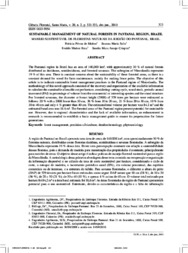Sustainable management of natural forests in Pantanal Region, Brazil.
Sustainable management of natural forests in Pantanal Region, Brazil.
Author(s): MATTOS, P. P. de; SALIS, S. M. de; BRAZ, E. M.; CRISPIM, S. M. A.
Summary: The Pantanal region in Brazil has an area of 140,000 km², with approximately 30 % of natural forests distributed as deciduous, semideciduous, and forested savannas. The subregion of Nhecolandia represents 19 % of this area. There is constant concern about the sustainability of these forested areas, as there is a constant demand for wood for farm maintenance, mainly for making fence poles. The objective of this article is to indicate sustainable forest management practices in the Pantanal region of Nhecolandia. The methodology of this novel approach consisted of the recovery and organization of the available information to calculate the sustainable allowable cut per hectare, considering: cutting cycle, wood stock, periodic annual increment (PAI) in percentage of volume from the commercial or interesting species and the stand structure. For forested savannas, the diameter at breast height (DBH) of 529 trees per hectare were estimated as follows: 28 % with a DBH lower than 10 cm, 36 % from 10 to 20 cm, 21 % from 20 to 30 cm, 10 % from 30 to 40 cm and only 4 % greater than 40 cm. The estimated total volume per hectare was 84.2 m³ and the estimated basal area was 18.6 m². The forested areas of the Pantanal region present potential for sustainable use. However, due to regional characteristics and the lack of available information, an enhancement in research is recommended to establish a basic management guide to ensure its perpetuation for future generations.
Publication year: 2010
Types of publication: Journal article
Unit: Embrapa Forestry
Keywords: Floresta natural, Manejo sustentável, Nhecolândia, Pantanal
Observation
Some of Embrapa's publications are published as ePub files. To read them, use or download one of the following free software options to your computer or mobile device. Android: Google Play Books; IOS: iBooks; Windows and Linux: Calibre.
Access other publications
Access the Agricultural Research Database (BDPA) to consult Embrapa's full library collection and records.
Visit Embrapa Bookstore to purchase books and other publications sold by Embrapa.

